Smolensk war 1632-1634
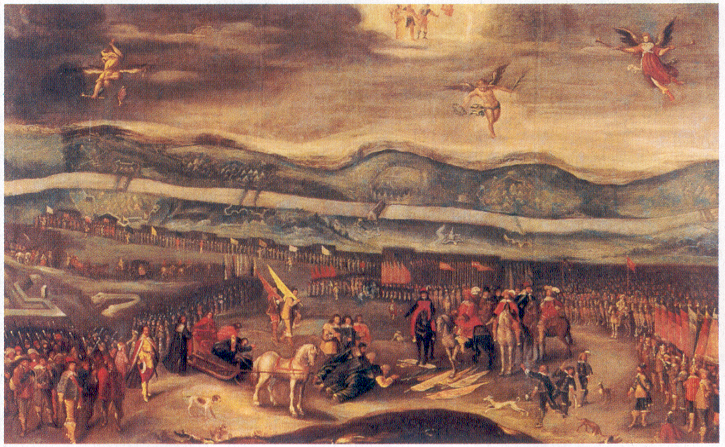
During the Smolensk War 1632-1634. The Moscow government, using a favorable international situation, was the Thirty Years War (1618-1648), which linked the attention of the Commonwealth, sought to solve its territorial problems associated with the extremely unfortunate outcome of the war with the Poles at the beginning of the 17 century. Russia, under the terms of the Deulinskiy truce 1618, lost Smolensk and Seversk lands, which were previously returned to the Russian state during several bloody and protracted wars. As a result of the Time of Troubles, Russia had to again beat off these territories from the Polish-Lithuanian state.
By the beginning of the 1630-s, the Russian state was able to heal the severe wounds that had been inflicted by the Troubles and the invasion of the invaders. This was an unpleasant surprise for the Polish leadership, who believed that Russia was permanently withdrawn from "big politics". For the anti-Habsburg, Protestant coalition, and above all for the Swedish kingdom, the rapid state and economic (the financial stability of the state was achieved thanks to the tough royal monopoly on the sale of bread and other export goods) the revival of the Russian state and undisguised hostility to the Commonwealth opened up tempting prospects for using Russian military and financial resources. The calculations of the Swedish monarch Gustav II Adolf, who sought to draw the Russian state into the orbit of his policy, were fully justified. Despite his conclusion of the Altmark truce with Poland at the end of September 1626, which, in fact, left Russia alone with the Poles, the Moscow government continued preparations for the war previously agreed with the Swedes. The government of Tsar Mikhail Fyodorovich and Patriarch Filaret Nikitich did not hide the intention to return Smolensk and Chernihiv region, and in case of successful development of events to recapture the lands of Belarus and Ukraine. In addition, Moscow was promised not only military-technical support from Sweden, but also Turkish assistance (this hope was not justified). This was reported to the Moscow government by Swedish envoys Jacques Roussel, Johann Meller and Anton Monier. They explained the reason that made Sweden stop the war with Poland, which had been going on intermittently since 1598. Swedish diplomats referred to the need to start military operations against the Allied Commonwealth of the Catholic League, which oppressed the weak forces of German Protestants.
I must say that the Swedish kingdom rendered some help to Moscow. By direct order of the Swedish king of Russia, they transferred the secret technology of casting light (field) guns, the use of which on the battlefield gave the Swedish army a serious advantage over the enemies. At the beginning of 1630, cannon craftsman Julius Coet arrived in the Russian capital, setting up production of new cannons in Russia. In the 1632 year, the Tula and Kashira military factories, iron-smelting and iron-making enterprises were founded under the technical guidance of another Swedish envoy, Andrei Vinius. True, the assistance of the Swedish government in the modernization of Russian military production and the hiring of European specialists was generously paid for by the supply of Russian bread. The Swedish kingdom experienced tremendous financial difficulties and could contain a large army (it had 1632 in the 147 year thousand soldiers), only due to French subsidies and speculations of Russian bread, which was resold to Holland. For six years - 1628-1633., The export of cheap grain from the Russian state brought the Swedish royal treasury 2,4 million net profits of the reichsters.
The absence of a formal agreement on the interaction of Russian, Swedish and Turkish troops saved Poland from complete defeat. At the crucial moment, Russia was alone with the Polish-Lithuanian state. The Polish government was informed by France in the 1628 year about preparations for war started by Russia. Thanks to this warning, the Poles managed to conclude a truce with the Swedes and prepare to repel a Russian attack.
Preparing for war. Military reform
Preparing for war with a strong adversary demanded extraordinary effort and heavy financial expenditures from the Russian government. The focus was on improving the organization and armament of the Russian army. By 1630, the number of Russian army was brought to 92,5 thousand people. However, the Russian command could use no more than a quarter of these forces in offensive operations. Approximately 70 thousand people were in the city service. The need for military reform was obvious. At the beginning of 1630 of the year, orders were issued in Yaroslavl, Uglich, Kostroma, Vologda, Veliky Novgorod and other cities about recruiting boyar children to the tsarist service. Of them were going to form two soldier regiments, 1 thousand people in each. Alexander Leslie and Franz Tsetsner, hired abroad, were supposed to teach them the military business. All children of the boyars were promised a salary in the amount of 5 rubles. per year and feed money on altyn per day. Each soldier received official squeak, gunpowder and lead. So in Russia began to create the shelves of the "new system".
Initially, the regiments of the “new order” planned to be staffed with ungodly servicemen who, because of poverty, were unable to carry on service “with their city”. The infantry regiments of the "new order" were to supplement the local cavalry. Moreover, the noblemen-soldiers were not deprived of their estate rights and continued to be listed in the lists of the Bit Order. However, an attempt to form new infantry regiments only from service people “according to the fatherland” (birth) failed. The total number of boyar children who joined the soldiers did not exceed 60 people. I had to recruit free people of non-noble origin, Cossacks, Tatars, and others. By December 1631, there were already 3323 people in the shelves of Leslie and Tsetzner. Each regiment was divided into a 8 mouth. The regiment commanded: a colonel, a regimental great lieutenant (lieutenant colonel), a major (stronghold) and five captains. Under the command of the company captains there were: a lieutenant, an ensign, three sergeants (Pentecostal), quartermaster (okolnichy), captenarmus (patrolman over weapons), six corporals (esaulov), a healer, an underman, two interpreters, three drummers and 200 privates (of which 120 are squeaky muscheketers and 80 spearmen).
In 1630, military specialists and soldiers hired under Swedish mediation begin to arrive in the Russian state. They were received in Veliky Novgorod by Prince Vasily Baryatinsky, Yefim Samarin, and deacon Nicephorus Spiridonov. At the beginning of 1632, the number of soldiers' regiments was increased to six. Four regiments took part in the march to Smolensk, two more regiments were sent to the army in the summer of 1633.
The Russian government decided to extend the successful experience of creating infantry soldiers' regiments to cavalry. From the middle of 1632, the first Reitarsky regiment began to be formed, the initial number of which was defined in 2 thousand people. The cavalry service was honorable and traditional for nobles, therefore impoverished service people readily enrolled in reiters. In addition, service in the cavalry regiment was paid more generously - 3 rubles per month and 2 rubles for the maintenance of combatant horses. By December 1632, the Reitarsky regiment had 1721 privates. The command decided to increase the size of the regiment to 2400 people, forming a special dragoon company. The Reitarsky regiment consisted of a 14 company, headed by captainers.
Already during the Smolensk war, the government formed a dragoon regiment, two soldier regiments and a separate soldier company. They were staffed from dochechnyh people taken from monasteries and estates, the owners of which themselves could not speak on the campaign (retirees, nedorosley, widows of service people, etc.). At war, they took one armed cavalry with 300 quarters of the earth. The dragoon regiment consisted of 1600 people divided into 12 companies, 120 privates in each. Dragoons received from the state horses, weapons, allowance for the 4 ruble per year for a saddle and clothing, and a monthly feed. The dragoons were armed with peelers (or muskets) and pikes. The regiment had its own artillery - 12 small guns with ammunition in the 24 core for each gun.
Thus, for three and a half years before the war and during its time, the government formed the 10 regiments of the new system, with a total number of about 17 thousand people. By the beginning of the war, six regiments were ready - 9 thousand soldiers. The Moscow government also decided to use mercenaries in the war with the Polish-Lithuanian state. The recruitment of four mercenary regiments was carried out by the colonel of the Swedish service Alexander Leslie, who was personally sent to Russia by the Swedish monarch. In the Russian army, he received the rank of "senior colonel" (he corresponded to the rank of general) and went to the German Protestant principalities, where he collected 5 thousand people and sent them to the Moscow kingdom. However, this experience was unsuccessful. The Thirty Years War was in full swing, the demand for professional military was extremely high in Europe itself, so Leslie barely scored four regiments, and their composition was of low combat qualities.
The Moscow government in 1632 considered that the task of forming an efficient army was solved, hoping for support from Sweden and the Ottoman Empire, and decided to go to war with the Commonwealth. The Swedes looked more realistic at the state of the Russian army. Thus, the Swedish resident I. Meller in a report written in July-August 1632 reported that Russia was not yet ready for war.
(Source of maps Electronic encyclopedia and library Runivers).
War
The event that precipitated the beginning of the war between Russia and Poland was the death of King Sigismund III. The Russian government decided to use this moment and went on a demonstrative violation of the Deulinsky truce concluded for a period of 14,5 years (formally, it ended with 1 June 1633 of the year). In June 1632 of the year, the Zemsky Sobor was held, which supported the decision to start a war with Poland. The decision of the Moscow government was not shaken by the unexpected attack of the Crimean Tatars, who in June invaded the southern Ukraine of the Russian state. An interesting fact is that the Crimean Khan violated the strictest ban of his overlord Turkish Sultan Murad IV, who at that time was interested in maintaining allied relations with Moscow. It was the first major campaign of the Crimeans for many years of calm.
Tatar strike delayed the performance of the main Russian forces to Smolensk for three months. Only 3 August 1632, advanced units of the army under the authority of the boyar Mikhail Borisovich Shein and Okolnichy Artemy Vasilyevich Izmailov made a campaign. 9 August made the main forces, they went to the border Mozhaisk, where it was planned to complete the acquisition of the shock group. Because of the dangerous situation on the southern frontier regiment gathering was delayed until the beginning of autumn. Only 10 September Shein received a decree on the start of hostilities against the Polish-Lithuanian state. 32-thousand Russian army at 151 gun and 7 mortars launched a campaign. This loss of time will have a fatal effect on the outcome of the campaign.
Despite the fall of the muddy season, which delayed the movement of artillery and carts, the beginning of the war was successful. Russian soldiers liberated Serpeysk, Krichev, Dorogobuzh, Belaya, Trubchevsk, Roslavl, Starodub, Novgorod-Seversky, Pochep, Baturin, Nevel, Krasny, Sebezh and other cities and towns in October-December 1632.
Siege of Smolensk. December 5 1632, the army was collected from Smolensk. However, the transportation of artillery was delayed for months. The “great” cannons (“Inrog - Pud and 1 grivenok that shot the cores,“ Pasynok ”- 30 pood, 1 grivenok,“ Wolf ”- 15 pood, etc.) were delivered to the army only in March 1 of the year. Until that time, Russian troops were in no hurry to storm the first-class fortress and were engaged in the preparatory work.
The Polish garrison counted, according to defectors, about 2 thousand people. The defense of Smolensk was led by Samoylo Sokolinsky and his assistant Yakub Voevodsky. The garrison had significant food supplies, but lacked ammunition. The Poles, despite the insignificance of the garrison, were able to hold out for 8 months before the arrival of the Polish army under King Vladislav IV (he was elected in November 1632 of the year).
Smolensk was a powerful fortress, which could only be taken with a strong artillery and carrying out the correct siege. The time chosen for the siege was unsuccessful. Usually with the beginning of late autumn, the troops were taken to winter quarters. Deviations from this rule, in the absence of a regular supply system for the field army, often resulted in heavy defeats for the troops, which operated in isolation from the main bases. The siege of Smolensk confirmed this rule. In the winter of 1632-1633. Russian troops were limited to the blockade of the fortress (and even then it was not complete). Only on the night of Christmas was an attempt at a sudden assault, but the Poles were on their guard and the besiegers stopped the attack.
After the supply of artillery, cannon fire and undermining mine was destroyed part of the fortifications of the city. However, the Poles had time to make behind the walls a loose earthen rampart with artillery batteries and successfully beat off two Russian storming - May 26 and June 10 1633 of the year. These failures demoralized the army of Shein, the Russian army moved to a passive siege.
In addition, the activity of the Russian army was restrained by the actions of 6-thousand. groups of Lithuanian troops under the command of Alexander Gonsevsky and Christopher Radziwill, who stood 40 versts from Smolensk in the villages of Krasnoe and Bayevo. Despite its comparatively small number, the enemy group constantly disturbed the Russian army. On the night of February 26, 1633, the enemy was able to transfer reinforcements of about 300 people to the city. True, the second group of reinforcements got lost and was eliminated by Russian troops on the morning of February 27. Then Gonsevskiy managed to transfer more 600 people and ammunition necessary for the garrison through the Pokrovskaya mountain. This allowed the garrison to repel Russian attacks and hold out until the royal army approached. The commander of the Advanced Regiment, Prince Semyon Prozorovsky, offered to attack and destroy the insignificant forces of Gonsevsky until they received help. However, the commander-in-chief took a wait-and-see attitude by giving the initiative to the enemy. In the end, this led the army to defeat.
Fighting in other directions. Military operations were not limited to the siege of Smolensk. Russian governors tried to strike at the enemy in other directions. In turn, the enemy tried to seize the initiative.
At the end of December 1632 - early January 1633, enemy units penetrated into Sebezhsky district and under Putivl. This attack is quite easily repelled. Thus, Russian archers and equestrian Cossacks overtook and destroyed a Korsak detachment (20 people) on the Orley River in 200 versts from Sebezh. At the end of January, another enemy unit under Colonel Komar was defeated near Sebezh. 27 February 1633 G. 5-th. Lithuanian squad under the command of Colonel Piasochinsky tried to capture Putivl. Voivods Andrei Mosalsky and Andrei Usov repulsed the enemy attack and defeated the enemy by making a sortie.
In March, 1633, 2-th. An enemy detachment under the command of Colonel Wolf attacked Starodub, but was unable to capture a well-fortified city. In April, the Poles unsuccessfully attacked Novgorod-Seversky, and in May - again Putivl. In June, 1533, the southern Russian border crossed the 5-thousand Zaporozhye squad. Zaporozhye Cossacks took Valuyki and besieged Belgorod. But 22 Julia 1633, during the storming of Belgorod, the Cossacks suffered a heavy defeat, having lost only 400 people killed and retreated. The defenders during the assault staged a sudden sortie, destroying siege devices and turning the enemy to flight.
In the north-western direction, Russian troops under the command of Peter Lukomsky and Semyon Myakinin at the end of May 1533, went from Great Onions to Polotsk. Polotsk was severely ravaged, burnt down and the fortress was burned, the Lithuanians were able to with great difficulty keep only the internal lock. On the way back, Russian troops completed the destruction of the Polotsk povet. In the summer of 1633, Russian troops carried out raids on Vitebsk, Velizh and Usviat sites.
In the summer - autumn of 1633, a strategic turning point occurred in favor of the Polish-Lithuanian state in the war. In May-June 1633, a new major invasion of the Crimean Nogai forces was made. Tatars under the authority of the "prince" Mubarek-Giray invaded the southern Russian counties. Crimean and Nogai units broke through the line on the Oka River and reached Kashira. Large territories of Moscow, Serpukhov, Tarusa, Ryazan, Pronsky and other districts of the Russian state were devastated. The Polish-Lithuanian, Tatar-Nogai and Zaporizhzhya attacks were to divert Moscow’s forces from Smolensk and, apparently, fulfilled their role.
Defeat at Smolensk. 9 May 1633 The Polish army marched from Warsaw to help the Smolensk garrison. King Vladislav wanted with one blow to decide the outcome of the war in his favor. 25 August its 15-th. army approached Smolensk. Shein had already lost part of the army by this time due to the massive desertion, many servicemen were returning home after learning of the Tatar invasion.
The commander in this situation took a passive position. This predetermined the defeat of the Russian army. 28 August 1633, King Vladislav went to the assault on Russian fortifications. The main blow of the Polish army was directed to the Pokrovsk mountain, where defense was considered the weakest. Against the soldiers' regiment, Yuri Mathiason (he had by that time about 1300 men), 8 thousand infantry and cavalry were sent. However, the Russian soldiers held the fortifications on the mountain, they failed to break through their defenses and the Poles retreated. 11 and 12 September The Polish-Lithuanian army attacked Pokrovskaya Mountain again. Regiment Matajson again showed perseverance and repelled all attacks, but on September 13 commander-in-chief Shein ordered to leave the position. September 18 Poles attacked the south-western position of the Russian army, which defended the soldiers' regiment of Heinrich von Dame, numbering about 1,3 thousand people. All enemy attacks were repelled, but on September 19 Shein ordered to leave this position as well. The commander-in-chief narrowed down the front of the defense, since the heavily depleted troops could not hold their previous positions. 20 September the main battles were in the southeast. Here, Prince Prozorovsky kept the defense; after receiving the order to withdraw, he made his way to the main camp with difficulty.
As a result, the Russian army was defeated, the siege of Smolensk was lifted. However, the army of Shein still maintained combat capability and could retreat in order to continue the struggle, but for this it was necessary to abandon the artillery. The commander in chief did not dare to make such a difficult decision and ordered the construction of new fortifications. October 9 Polish-Lithuanian army, reinforced 20-thousand. Zaporozhye army hetman Timothy Arandorenko, captured the village of Larks, blocking the Moscow road, and this blocked the army Shein. The regiment of mercenaries of Colonel Thomas Sanderson and soldier of the regiment of Colonel Tobias Unzen (killed in battle) who defended Zhavoronkovo Mountain were attacked by hussars and with heavy losses retreated to Shein camp. The royal army could not destroy the Russian troops in several battles, but completely blocked them, surrounding the line of its fortifications.
For four months, the besieged Russian army suffered from food shortages, firewood, and disease. In mid-February, 1634, under pressure from German colonels, Shein agreed to begin negotiations with the Polish king on the terms of “honorable” surrender. Under the terms of the agreement drawn up by Russian voivods and hetman Christopher Radziwill, which was signed on February 21, Russian regiments with personal weapons, banners, 12 field guns, but without siege artillery and all-over property received the right to freely retreat to their border. The most difficult condition for capitulation was the issue of the extradition of all defectors. In the future, this item will lead to the execution of the commander-in-chief. Shein took 8056 warriors from Smolensk, another 2 thousand of the wounded and sick were drafted before being healed in the camp. Under the terms of the contract, after the treatment, they were to return to Russia. In addition, half of the mercenaries went to the service of the Polish king.
Ending war
The difficult position of the main army near Smolensk forced the Moscow government to urgently proceed to the formation of a reserve army, which was headed by the famous military leaders D. Pozharsky and D. Cherkassky. The basis of the army was the sovereign's court and the detachments of city nobles, urgently transferred to Mozhaisk. However, this army did not take part in the battles, apparently playing the role of a strategic reserve.
Russian forces in other directions were shackled by the blows of enemy troops. In January, 1634, under Sebezh came 2-thousand. detachment under the command of Colonels Luzgin and Muravitsky. The enemy was going to attack in the direction of Opochka, the Great Onions and Nevlya. In early spring, the enemy forces approached the Great Bows. March 29 was a fierce battle, which lasted from morning to evening. Polish-Lithuanian squad was defeated. In May, the Russian squad defeated the enemy near the town of Ozerische.
In the western direction, after the victory at Smolensk, the main Polish army attempted to sink into the depths of the Russian state, but was stopped by the heroic defense of the Belaya garrison (the fortress was defended by no more than 1 thousand). The Poles tried to undermine the fortifications with the help of a mine, but their engineers were mistaken. The explosion did not damage the wall, but around 100 Polish infantrymen died. Then the Russian garrison made a successful raid, during the battle the Polish king himself was wounded. In total, during the battles for the White Fortress, the Polish army lost up to 4 thousand people. The siege lasted from February to March 1634. This unexpected failure forced the Polish government to stop the campaign and begin peace negotiations with Moscow.
Polyanovsky world
Russia was represented by the boyar Fyodor Sheremetev, the okolnichy Alexey Lvov, the okolnichy Stepan Prostev and clerks Grigory Nechaev and Vasily Prokofiev. The Polish-Lithuanian state was represented by Mikolaj Voronets (Voronovsky). By the beginning of the summer of 1634, the parties agreed on the most controversial terms of a future contract.
4 (14) June 1634, in the village of Semlevo on the Polyanovka River, between Vyazma and Dorogobuzh, a peace treaty was signed between Russia and the Commonwealth. Poland was represented by Crown Chancellor Jakub Zadzik (Jadzik) and Lithuanian Hetman Christopher Radzivil. Polyanovsky peace confirmed the borders between the Moscow kingdom and the Polish-Lithuanian Commonwealth under the Deulinskiy truce 1618 of the year, i.e. Smolensk and Chernihiv region remained behind the Poles. Only the city of Serpeysk with a small district and a number of other small territories went to Russia. The Poles pledged to hand over to Moscow a Russian Orthodox boyars ’sacramental record to the Polish Tsar Vladislav, who had now become king of the Commonwealth, elected Russian Tsar to 1610. Vladislav for something in 20 thousand rubles refused the title of "sovereign of all Russia." In addition, the Poles undertook to return the body of the captive and tortured Russian sovereign Vasily Shuisky. There was an exchange of prisoners without ransom.
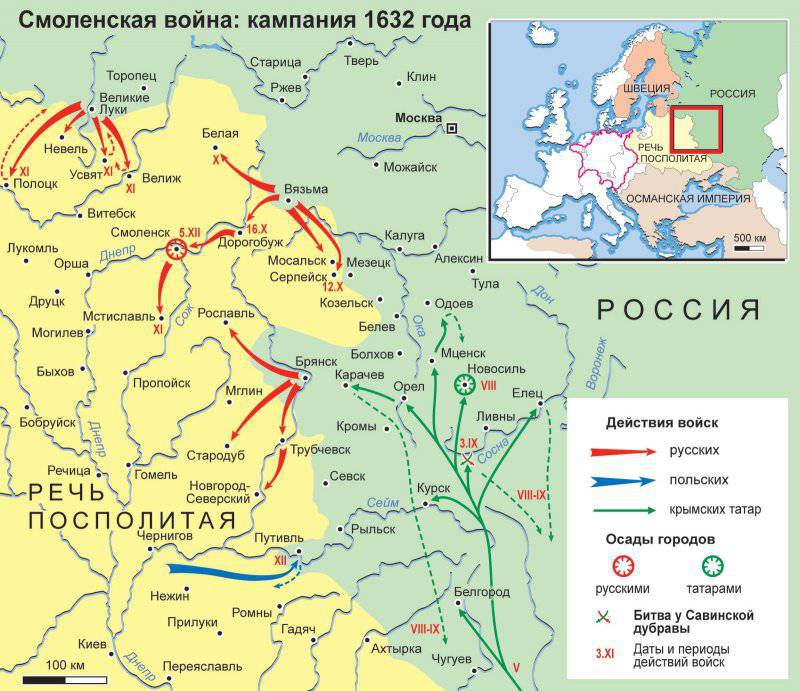
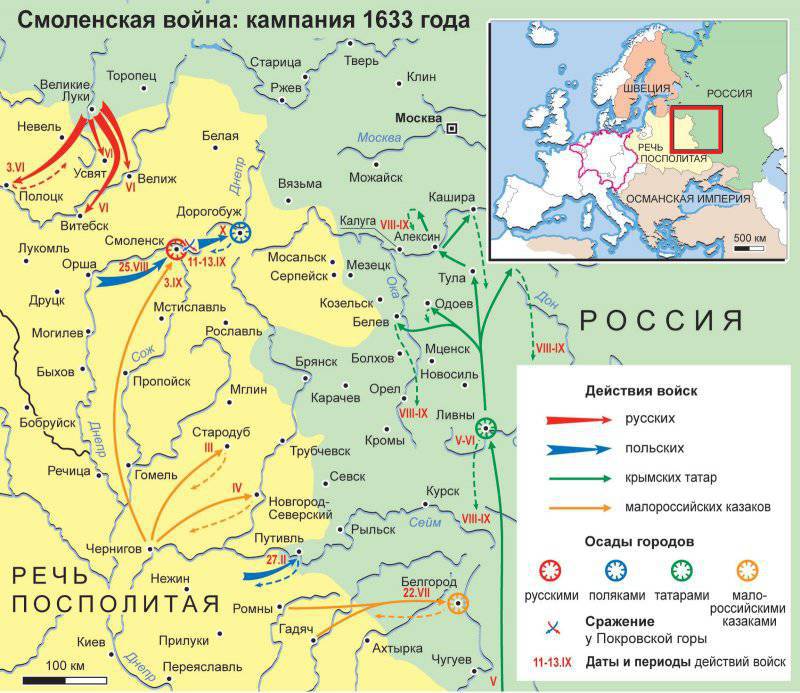
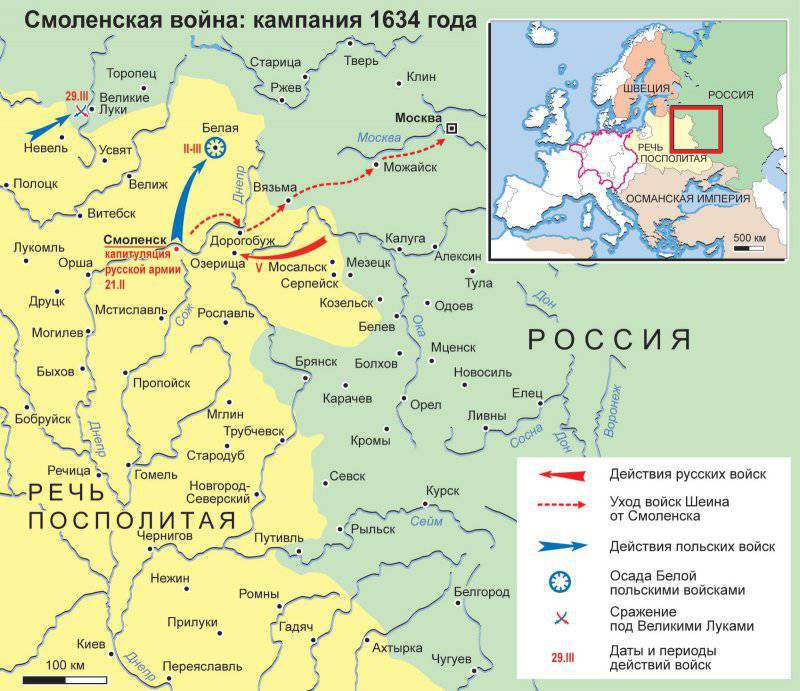
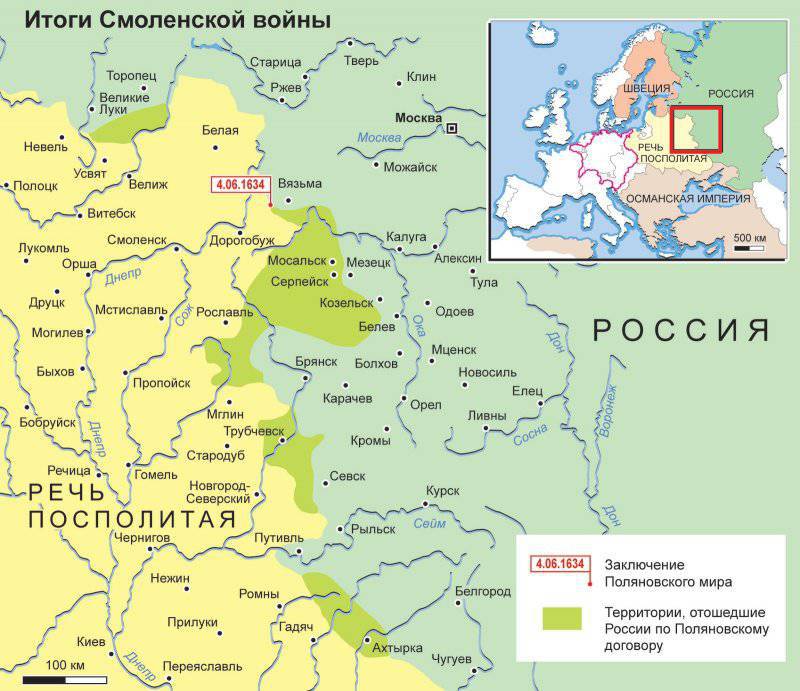
Information